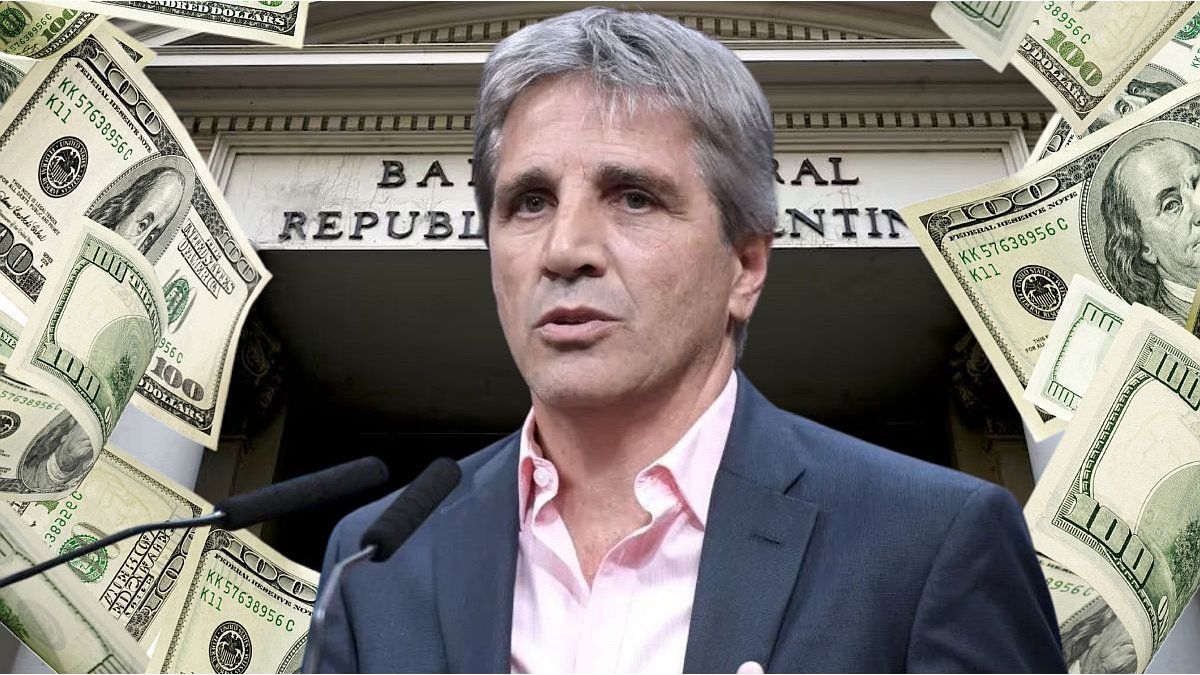Yesterday, for the first time, The official dollar crossed the imaginary midline of the exchange band agreed with him International Monetary Fund (IMF)a level that some analysts, under their “Maginot Line” in allusion to the historic French fortification of the 30s.
In history, the Maginot line It was a defensive barrier built by France to stop a possible invasion of Germany After World War I. However, that sense of security on the French side It was ineffective When the Germans surrounded her in 1940, exposing her vulnerability. Similarly, the crossing of the dollar for this “imaginary” line marked a turning point in the government exchange strategy, activating an immediate reaction.
So much so that, this Tuesday afternoon, The Minister of Economy, Luis Caputo, made statements After the recent visit of the IMF mission the last week, announcing that the Treasury will assume the accumulation of reservations instead of the Central Bank of the Argentine Republic (BCRA).
Dollars
The dollar, at the limit: what can happen and what do they expect in the government.
The central fact that the reader deserves to know is that this move seeks to correct a “Non forced error” of the economic team that the IMF revealed to him: the prioritization of disinflation on the accumulation of reserves, which has generated A vicious circle of high interest rates, disagreement of the exchange rate and increase in external risk.
The maginot exchange line: an unexpected breakdown
The crossing of the dollar for the “Maginot Line” – the exact midpoint of the exchange band agreed with the IMF, located between $ 1,000 and $ 1,400 per dollar – was not a minor event. This band allows the exchange rate to fluctuate freely, with a monthly widening of 1% at both ends. This Tuesday, the official dollar reached $ 1,222, a level that unleashed alarms in the government and activated a new dynamic.
Like the historical Maginot line, which gave a false security sensation To France, this imaginary line in the exchange market revealed the fragilities of the economic strategy. The non -intervention of the BCRA in the market, designed to prioritize disinflation, allowed the dollar to move without control, weakening reserves and generating instability.
A PXQ report analyzes what happened. Maintains that this lack of intervention of the BCRA inside the exchange band He led to a fall in net reserves to negative field, preventing the re -delighted economy. In turn, this caused a monetary contraction that triggered interest rates, making credit, key engine of economic growth.
Since May 2024, private sector deposits grew 110% in real terms, while the deposit/credit ratio went from 2.4 to 11.2, reflecting a restricted credit offer. This vicious circle – some rates to stop inflation that attract short -term dollars, but disagree with the exchange rate – has raised external risk, maintaining the country risk at high levels.
Luis Caputo replies: the statements that arrive post-fmi
After the visit of the IMF mission last week, which evaluated compliance with the program agreed in April 2025 for US $20,000 million, the minister Luis Caputo went out to defend the new strategy with A challenging tone, not to mention the change that operated inside doors. In an event at the Universidad Austral, he said: “Buy, don’t miss it, champion”mocking those who alert About a cheap dollar that could be shot at $ 5,000. He added: “Don’t miss it, champion, the dollar at $ 900 is an opportunity that will not return.” Yesterday, after the crossing of the Maginot line, Caputo intensified his speech: “The dollar crossed half of the band, but we are ready. The treasure is going to buy dollars to strengthen reservations without destabilizing the market. ”
The reader must think if government statements They reflect an attempt to project control. But you will also have to evaluate whether they address – or do not – some Solution for the structural problem indicated: The prioritization of disinflation has sacrificed exchange stability, even if it seems a paradox.
The Treasury will assume the purchase of dollars through three modalities: Direct intervention in the change market (MLC) to avoid – supposedly – that the dollar falls to the band, issuance of debt in local currency in exchange for reserves, and privatization of public assets with foreign exchange payments. The BCRA, meanwhile, will collaborate with Repo operations, but will maintain its policy not to intervene directly while the exchange rate remains inside the band. Since the announcement of these measures, the reserves increased by US $ 2,800 million, promoted by a repo of US $ 2,000 million with international banks and the reopening of the Bonte30 bonus, which attracted US $ 500 million of non -resident investors.
The unpaired error: a vicious circle
As indicated, the initial strategy applied by the Government was conceived by the IMF as an “non -forced error” that has generated a vicious circle. The obsession with disinflation, key in the government’s electoral agenda, led to keeping high interest rates to attract short -term dollars. However, this neglected the exchange rate, preventing the BCRA from accumulating reserves. As a result, The country risk did not fall from the 720 basic pointsfar from the 400-500 necessary to re-enter international markets. In addition, the lack of intervention allowed the dollar to range between $ 1,150 and $ 1,200, without reaching the band of the band, despite the fact that the complex of the agro -export sector liquidated US $ 1.7 billion daily in May and June 2025.
On the other hand, analysts also question the official narrative that treasure purchases do not generate monetary expansion. They argue that the transfer of $ 1.7 billion in BCRA profits to the Treasury on April 25, 2025 The broad monetary base has already expanded (BMA), which implies that these purchases have a monetary effect similar to that of a direct intervention of the BCRA. This initial error, combined with the crossing of what we call the “Maginot Line”, tells the Government to inflationary risks just when it seeks to consolidate its anti -inflationary strategy for the legislative elections of 2025.
Political and economic risks to the order of the day
With the September 2025 elections on the horizon, exchange volatility threatens the main electoral letter of the Government: disinflation. The decrease in agricultural currency supply in the third quarter could press the dollar upwards, complicating this goal. Caputo said that the government is prepared to intervene directly in the exchange market, even raising interest rates or selling future dollar contractswhose position sold reached -U $ 1,470 million in May 2025, the maximum since October 2023. However, these measures could aggravate credit contraction and stop economic recovery.
In the political sphere, the Buenos Aires elections will be a key thermometer. A victory of the ruling party in a Peronist bastion could strengthen the government, while an opposition triumph could exacerbate the perception of risk in the markets. The PXQ consultant compares the disqualification of figures such as CFK with the case of Lula in Brazil in 2018, warning about the risk of institutional erosion that could affect confidence in the judicial and electoral system.
Source: Ambito




